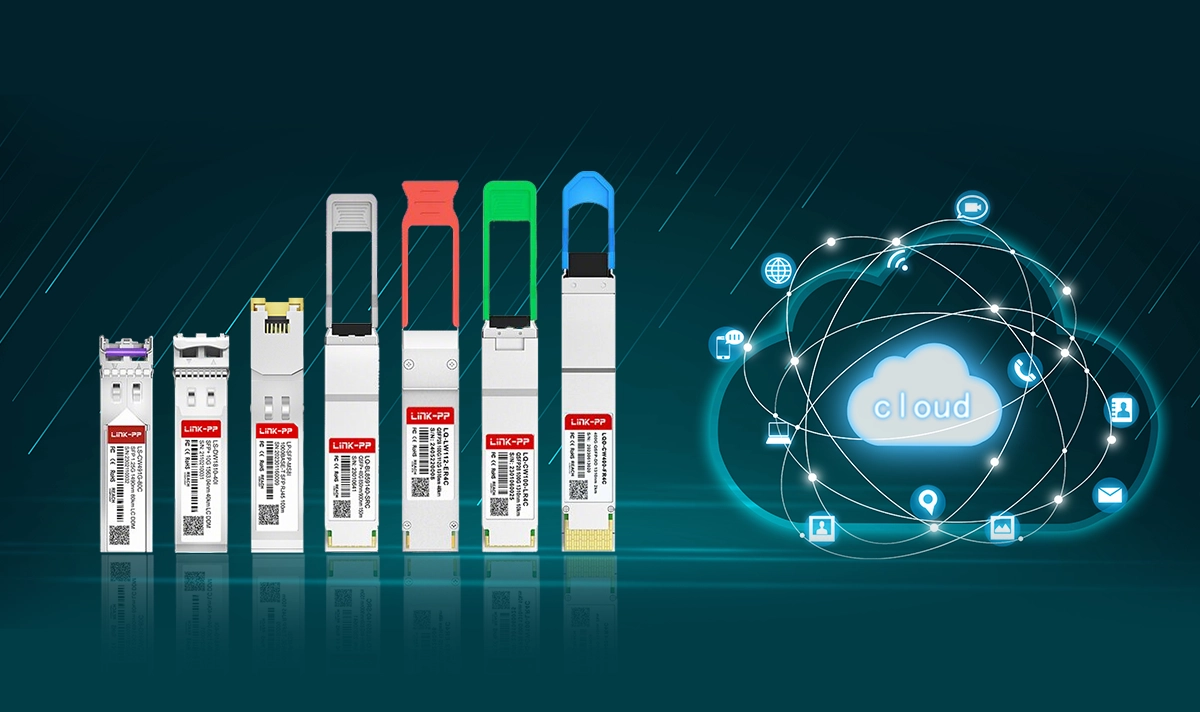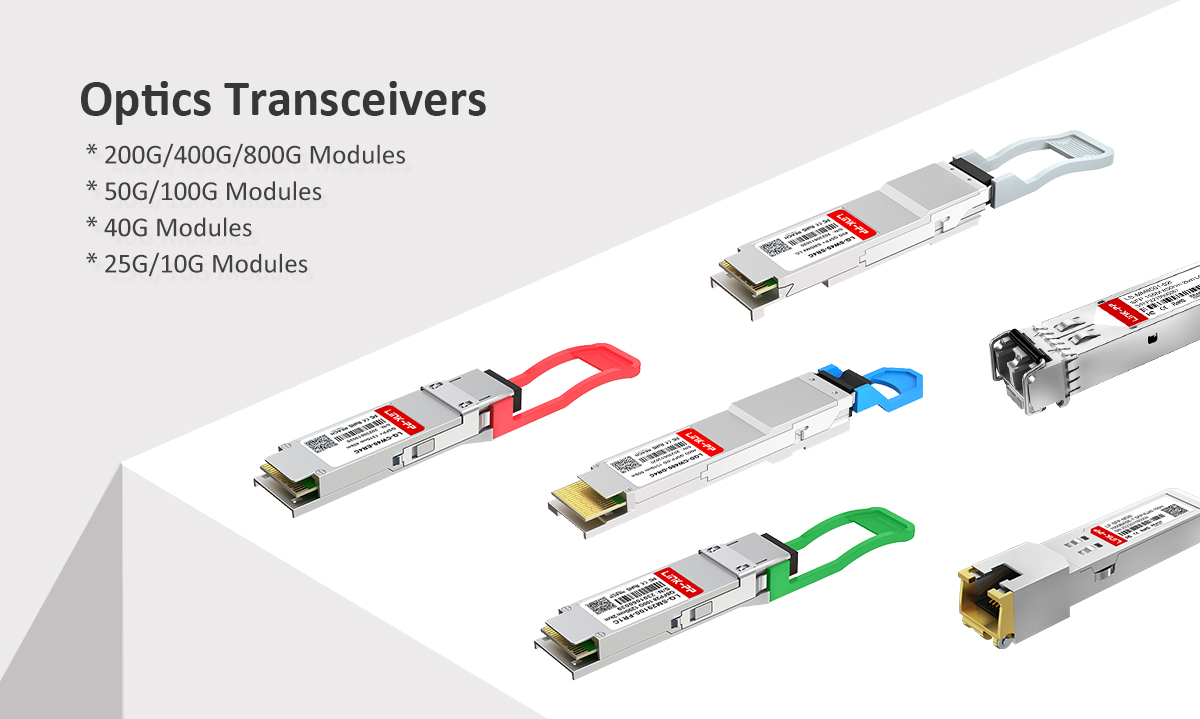
In the invisible architecture of the digital world, where we stream movies, collaborate in real-time, and leverage powerful AI tools, data travels at the speed of light. This miraculous feat is made possible by the unsung heroes of the data center: optical transceivers. These tiny, powerful devices are the fundamental building blocks of cloud computing, enabling the massive, high-speed data exchange that defines our era.
This article delves into the application of optical transceivers in cloud computing, exploring their function, key types, and how choosing the right technology, like LINK-PP's advanced solutions, is critical for scalability and performance.
📝 What is an Optical Transceiver? The Basics
An optical transceiver is a compact, hot-pluggable device that serves as the interface between a network switch and a fiber optic cable. Its name defines its core function:
Transmitter: Converts electrical signals from the switch into optical (light) signals.
Receiver: Converts incoming optical signals back into electrical signals.
This conversion is what allows data to travel over vast distances through fiber optic cables with minimal loss and latency, forming the backbone of global networks.
📝 Why Optical Transceivers are the Lifeblood of Cloud Data Centers
Cloud computing demands immense bandwidth, ultra-low latency, and rock-solid reliability. Optical transceivers meet these demands head-on:
Unmatched Speed and Bandwidth: As cloud services evolve (think 4K/8K streaming, Big Data analytics, IoT), network traffic explodes. Modern transceivers like 100G, 400G, and emerging 800G provide the necessary pipeline to handle this deluge of data without bottlenecks.
Low Latency: For real-time applications like online gaming, financial trading, or autonomous vehicle coordination, every millisecond counts. Light transmission through fiber offers the lowest possible latency, far superior to traditional copper cables.
Energy Efficiency: Data centers are massive consumers of power. Newer generation optical transceivers are designed for higher data rates per watt, reducing operational costs and environmental impact—a key consideration for sustainable cloud infrastructure.
Scalability and Density: Their small form factor (e.g., QSFP-DD, OSFP) allows network switches to host dozens of ports in a single rack unit. This high port density is essential for scaling cloud data centers to meet growing demand.
📝 Types of Optical Transceivers in Cloud Applications
Not all transceivers are created equal. Their use case depends on transmission distance and data rate. Here’s a breakdown of common types used in cloud data centers:
Form Factor | Data Rate | Typical Use Case in Cloud Data Centers | Max Distance (Approx.) |
|---|---|---|---|
SFP+/SFP28 | 10G / 25G | Top-of-Rack server connections, storage area networks (SAN) | Up to 120km |
QSFP28 | 100G | Spine-leaf network architecture, core switching | Up to 80km |
QSFP-DD/OSFP | 400G | Data center interconnect (DCI), high-performance computing clusters | Up to 120km |
QSFP56 | 200G | Longer-haul data center interconnects | Up to 120km |
📝 Choosing the Right Partner: The LINK-PP Advantage

In a high-stakes cloud environment, reliability is non-negotiable. Deploying generic or low-quality transceivers can lead to network downtime, data errors, and increased total cost of ownership (TCO).
This is where partnering with a trusted manufacturer like LINK-PP becomes a strategic advantage. LINK-PP optical transceivers are engineered for maximum compatibility, performance, and durability, ensuring your cloud infrastructure operates flawlessly.
For example, the LINK-PP QSFP-DD 400G DR4 is a powerhouse designed for high-density 400G applications within data centers. It supports up to 500m transmission on single-mode fiber, making it an ideal solution for short-reach data center interconnects and high-bandwidth cloud storage networks.
When you're looking for high-speed data center optical modules or reliable 400G QSFP-DD solutions, opting for a branded, quality-assured product is crucial for maintaining network integrity.
📝 The Future: What's Next for Optical Transceivers?
The evolution continues. The push towards 800G and 1.6T (Terabit) transceivers is already underway to support next-generation technologies like AI/ML workloads and the metaverse. Co-packaged optics (CPO), where the transceiver is moved closer to the switch ASIC, is another emerging trend promising even greater efficiency and speed.
📝 Conclusion: Powering the Cloud, One Photon at a Time
Optical transceivers are not just components; they are the critical enablers of the cloud revolution. Understanding their role, types, and the importance of quality is key for anyone involved in IT infrastructure and cloud management.
As cloud demands grow more intense, the technology inside these small modules will continue to advance, ensuring that data keeps moving at the speed of our ideas.
🚀 Ready to Optimize Your Cloud Infrastructure?
📝 FAQ
What is an optical module?
An optical module is a small device. It changes electrical signals into light signals. This helps data move fast through fiber optic cables. Data centers use these modules to link servers, switches, and storage.
Why do data centers use optical modules?
Data centers use optical modules for faster data movement. They send data farther than copper cables. These modules help networks stay reliable and easy to grow. They also save energy and make less heat.
How do optical modules support cloud computing?
Optical modules make networks faster and more reliable. Many users can use cloud services at the same time. These modules help data centers handle more data as cloud use grows.
Are optical modules expensive?
The price of optical modules depends on type and speed. Some cost more because they work over longer distances. Others cost more if they support higher speeds. Data centers pick modules that fit their needs and budget.
Can optical modules be upgraded easily?
Yes, engineers can upgrade optical modules by swapping them for new ones. Many modules use plug-and-play design. This makes upgrades quick and simple. The whole network does not need to change.




